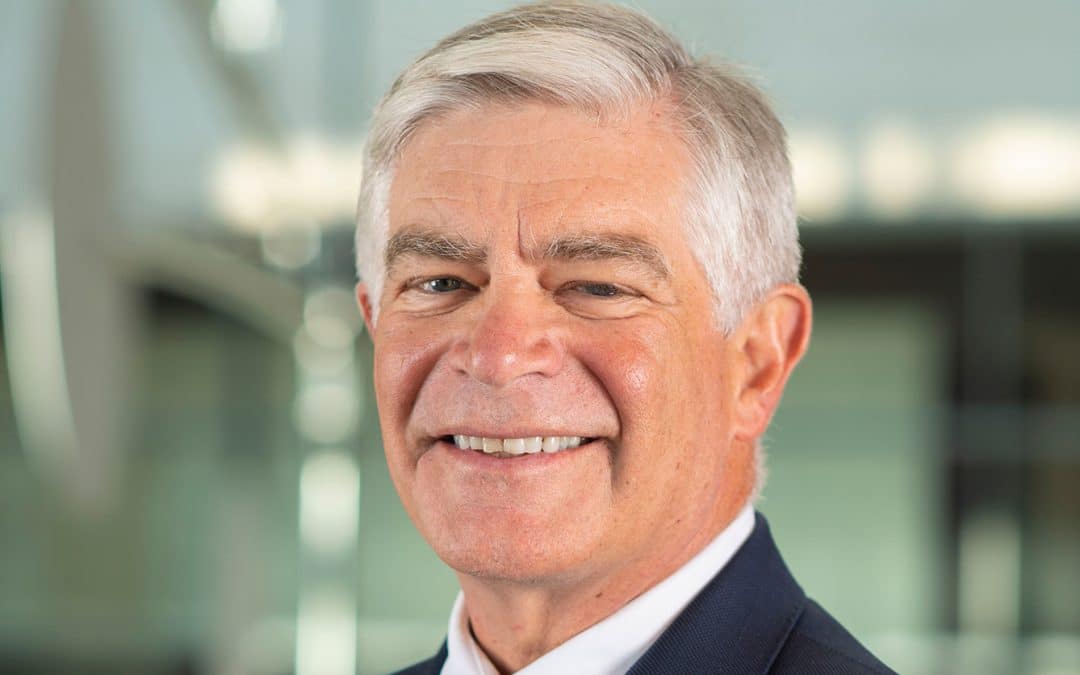Patrick T. Harker is president and CEO of the Federal Reserve Bank of Philadelphia. This article was adapted and edited from prepared remarks delivered at the recent Global Interdependence Center 42nd Annual Monetary and Trade Conference in Philadelphia.
Allow me to open with four brief statements. First, high inflation remains not only a leading concern of many Americans, but certainly also one of mine and my colleagues.
Second, the overall underpinnings of the American economy have proven nothing less than resilient, time and time again, despite the high rates leaning against aggregate demand for more than a year now.
Third, monetary policy overall remains positioned in restrictive territory to bring inflation back to its 2% target, while minimizing broader economic risks.
And fourth, we are still surrounded by an air soaked with uncertainty. There are a host of risks and known unknowns, but what I would like to emphasize is that the data haven’t, so far, resolved those. Indeed, data have been what I would describe as “choppy.” Not that this is unheard of. As the economy becomes more balanced, the chances of a miss on the upside or downside are more evenly distributed.
But the point stands, the data have not quite dissipated this uncertainty as I would have hoped they would. Well, then, maybe I should add a fifth — more data is essential.
With regard to inflation, as we all saw, the promising disinflation in the second half of 2023 unceremoniously halted through the first quarter of 2024. I had expected bumps in the road, but the Q1 2024 “bump” threatened to become a hill to climb. Yet, while the lack of progress toward the inflation target was concerning, inflation did not reignite.
And while I remain very attentive to inflation risks, the latest inflation data have been quite promising that progress on disinflation has resumed. But “promising” falls short of the confidence I want to have, before cutting rates, that inflation is on a sustainable path back to target.
Inflation has a range of impacts throughout the economy, but its greatest impact is on low- and moderate-income families — those who have already been pinching their pennies over the past two years and aren’t sure how much more they can pinch. The situation has been made much worse as inflation hit hard the basic necessities: shelter, food, transportation.
Fortunately, we have seen quite a bit of improvement in many categories. Food prices have been essentially flat for several months now. Gas prices came down sharply in 2023. Vehicles, new and used, are cheaper now than a year ago. Unfortunately, the long-term stubbornness of shelter inflation, especially, remains a concern along with the continually high rate of inflation in the services sector, notably auto insurance and repairs — echoes of the past runups in vehicle prices, most likely.
The CPI inflation release for May was very welcome, and the kind of price data I want to see more of. But I would add the caveat that our inflation target is the PCE price index, not the CPI, the May reading of which is not due for another 11 days. If the higher inflation in the first quarter was a bump in the road, I want to make sure that the lower inflation we are seeing so far in the second quarter is not a pothole.
I remain focused on seeing inflation return to a clear path toward our target rate of 2% annually.
Overall, there is much in the American economy that allows me to remain optimistic. Unemployment remains low, job creation appears robust, and labor market participation is within range of its historic levels. So, the labor market remains healthy, while supply and demand are coming into better balance, as shown by the average number of job openings to job seekers, as well as other measures of labor market tightness, like quits and job-to-job transitions, both of which are gently normalizing. Gross domestic product, while leveling off in the first quarter from the close of 2023, continues to grow. We have seen some moderation in consumer spending as of late, and I am keeping a close eye on household finances.
All said, as recent Fed survey data show, overall measurements of economic well-being among American households remained essentially unchanged from 2022. The percentage of respondents saying they were “doing at least okay financially” in 2023 was roughly where it was the prior year, for example. And economic resilience as measured by respondents’ ability to afford an emergency $400 expense similarly remained unchanged.
Yet inflation continued to eat away at the sense of true economic well-being. More respondents said their expenses increased than said their incomes increased. And, I should add, these results are in line with what I hear as I speak with residents and contacts across the Third District. This is a strong convergence of soft data.
So, to me the key is wrestling inflation back down to target. And, in this, progress has been uneven. Inflation is way down from where it was a year ago, but with the high inflation readings between January and March factored in, progress in recent months has been modest.
I believe that the current policy interest rate, which has been held steady for nearly 11 months, will continue to serve us well for a bit longer, holding us in restrictive territory to bring inflation back to target and mitigate upside risks.
Over the ensuing months, I will continue to closely monitor the data — both hard and soft — on inflation, labor markets, and economic activity. And I will be asking whether it is, or is not, the right time to decrease the policy interest rate.
When that time will be, exactly, I don’t yet know. I have a forecast for inflation, employment, and economic activity: slowing but above trend growth, a modest rise in the unemployment rate, and a long glide back to target for inflation.
And if all of it happens to be as forecasted, I think one rate cut would be appropriate by year’s end — as well as a medal for myself for best economic forecaster ever. Because any forecast remains just that: a forecast. It is not a lock-down commitment.
My commitment is to remain data dependent because this is how we get through the uncertainty and make sure inflation returns to target, sustainably.
Indeed, I see two cuts, or none, for this year as quite possible if the data break one way or another. So, again, we will remain data dependent.
This is a time when the independence of the Federal Reserve System — and beyond to that of other central banks — will be of utmost importance. This is a fraught time in our nation and world, which makes it all the more vital that we, as central bankers, remain not nonpartisan but apolitical. We at the Fed operate under our dual mandate to ensure price stability and maximum employment for the American people. That is our mandate, given by the U.S. Congress, and it is our goal.
To achieve this, we must make decisions by looking at all the data, not just a narrow set, and by asking and answering the right questions.
And that statement brings me to my final thoughts to share with you. How do we ensure we’re asking the right questions to begin with? I can say with great pride that the research team here at the Philadelphia Fed is filled with some of the brightest economic minds available. And I know that goes the same for the team in Washington and at our sister banks across the Federal Reserve System.
Whenever I speak to students studying economics, I’m quick to note that the Federal Reserve System is the largest employer of economists in the nation. I want these future economists to consider us as a potential career choice. I’m not just a central banker; I’m a recruiter!
Recently, I’ve been pleased to see that the makeup of these student audiences has become somewhat more diverse over time. To me, this next generation of economists isn’t just important because they are the ones who will sit at the desks of those who have gone on to retirement or other aspects of the field. What’s more important are the perspectives they will bring into these future positions. And we need voices that are not going to be afraid to challenge us into looking at old numbers with new eyes.
To foster this, the Philadelphia Fed has partnered with the National Association for Business Economics, or NABE, in an effort to bring more historically underrepresented individuals into the field of economics. But to be sure, we are not the only ones who have recognized the vital need for diversity not just in economic thinking, but in economic thinkers.
The simple reality is that the underrepresentation of women and minority students at the college and university level ultimately leads to an underrepresentation at the professional level.
Nearly a decade ago, in 2016, an article in the American Economic Association’s Journal of Economic Perspectives noted that the lack of diversity within the field of economics “hampers the discipline, constraining the range of issues addressed and limiting our collective ability to understand familiar issues from new and innovative perspectives.”
That concern was underscored by research released by the New York Fed in 2017. That research measured student diversity in economics programs through the attainment of bachelor’s degrees at hundreds of colleges and universities across the United States. It was a project that captured the annual makeup of classes from 2011 through 2015 — a yearly average of nearly 35,000 economics students. Overwhelmingly, the data showed that the presence of women and underrepresented minorities lagged well behind that of white males.
Now, certainly, there are many reasons why students may not choose to study economics. Perhaps the discipline’s moniker as the “dismal science” may hamper recruitment. But as we here know, economics is far more than just “guns and butter,” being able to define “opportunity cost” and “mutual exclusivity,” or understanding, let alone grasping, the minutiae of monetary policy.
So much of our world, and nearly every decision made by individuals and governments, whether they recognize it or not, is an economic decision at its heart — everything from the goods they purchase, to the jobs they take, to whether or not to go to school to study economics. And homogeneity in the economic discipline prevents us from being able to more fully investigate those decisions to more fully understand choices and trade-offs, and to move economics forward in a more meaningful way that captures the nuances of rapidly changing economies and societies.
Even just one year ago, researchers in a London School of Economics blog post wrote: “Diversity among economists is crucial for policymaking as it enables the inclusion of a wide range of perspectives and experiences, leading to more informed and effective decision-making.”
This goes far beyond an ability to understand hard data. We can take all the classes we want and become proficient in collecting hard data and making calculations that seek to understand decisions and influence policy. But hard data can only take a researcher so far. Equally important is the soft data — and there is no soft data that can be more important than a lived experience.
Or, as the Harvard Business Review succinctly asked in 2022: “Without many economists from less socioeconomically advantaged backgrounds, what kinds of perspectives, questions, and answers are we missing?”
For us here at the Philadelphia Fed, we know that increasing the diversity of those studying and practicing economics isn’t just good for ensuring that our workplace is more reflective of the world outside our walls; it is crucial to ensuring that the work we produce is more reflective, and therefore better, as well. It is vital, as well, to the reputation of that work.
In the words of that most preeminent of Philadelphians, Benjamin Franklin, “Glass, China, and Reputation, are easily cracked, and never well mended.”
So, my hope is for everyone here today to likewise commit to ensuring that the reputation of the economics discipline does not crack. I ask you to commit to ensuring economics remains relevant in the lives of those we aim to support through our work. I encourage you, if you have not already done so, to find local partners, whether it be directly with an institution of higher education or a business organization, to seek out and foster the economists of tomorrow.
Those economists, after all, are the ones who will eventually be sitting and standing where we are today. And we are going to want them to look back at this convening and build upon our work and progress not because we have all the answers, but because we recognize that we don’t and that many questions are yet to be asked.













